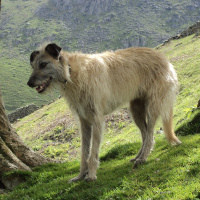Appearance of the Lurcher
|
| Given their mixed heritage, Lurchers are a breed of varied appearance. Most are fairly tall and lean, resembling their Greyhound parent. Their long limbs and muscular, deep-chested bodies provide speed and endurance when running. The Lurcher's head and muzzle are long and fairly narrow. Their triangular ears tend to remain semi-erect, with the upper tips turning down, although some have more pendulous ears. Their eyes are not too large, but should be evenly spaced and free from obstructions such as facial fur or skin folds. The Lurcher's tail is often long and thin. Given their mixed origins, there is a wide range of acceptable heights and weights for the Lurcher. As a general rule, they weigh between 27 and 32 kg and measure between 55 and 71 cm. However, weights and heights outside these parameters are not unusual. Coat type and color are also difficult to predict, and while some will have the short, fine coat of their Greyhound parent, others may have a longer, finer coat. Virtually any coat color is permitted, including black, white, fawn, gray, brindle and blue. White markings are a common feature. |
Temperament of the Lurcher
|
| As a working dog by nature, the Lurcher has the gentle, loving personality of the Greyhound, making it a charming pet to own. They bond well with their families and are generally very respectful and obedient. Athletes at heart, Lurchers love nothing more than to be free in nature and chase something. They can be quiet house guests, but only once their exercise needs have been met. For most, a rural home with outdoor access is preferable. When it comes to their natural instincts, Lurchers are rarely able to control themselves. Having been bred for centuries to seek out and hunt small prey, this is a task they will perform whenever given the chance. This characteristic means that Lurchers should not be left to fend for themselves in a public place, and many will need muzzles when outdoors. Similarly, they can't really be housed with smaller animals, such as rabbits or gerbils, as their prey drive is too powerful. |
Needs and activities of the Lurcher
|
| Lurcher-type dogs seem to be universally active in small movements, just like their Greyhound ancestors. Although they need a place to run a little every day, they tend to be real couch potatoes at home. In addition to running and walking, which should never be done off-leash due to this dog's highly developed prey drive, your Lurcher can enjoy and even excel in activities such as luring and agility training. They also tend to be very quiet compared to many breeds, and even the largest Lurchers can make suitable pets for people with smaller living spaces, provided they have enough activity during the day. |
Maintenance of the Lurcher
|
| The Lurcher is generally a fairly easy dog to care for, although this can vary somewhat, depending on the breeds that have been combined to develop your dog. In most cases, bathing will only be necessary a few times a year, and too frequent bathing may even remove the natural oils from this dog's coat, especially if it has inherited a weather-resistant double-layered coat from its parents. Those mixed with dogs such as Bull Terriers retain this short coat in one layer, which can usually be kept clean and healthy with weekly brushing with a rubber curry comb or a soft cloth with a damp towel. Many Lurchers can have a double coat that can sometimes be thicker and require more grooming, and dogs with Wirehaired Terrier influence can have a coat that requires occasional stripping. |







 English (United Kingdom)
English (United Kingdom)